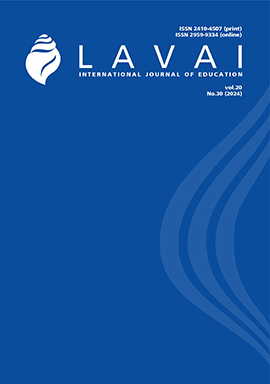The "Khorchin" embroidery result was experimented with in fine arts and local courses
DOI:
https://doi.org/10.5564/lavai.v20i30.3512Keywords:
Traditional culture, embroidery, lessons, creatureAbstract
Protecting and inheriting the culture of small nations with the development of technology and globalization is an important issue. One that takes up a lot of operational resources is the legacy of educational programs and content tools. The article reflects the results of a study on the possibility of implementing khorchin embroidery, one of the traditional cultures of the khorchin people living in the eastern part of China, in teaching secondary education schools. To achieve this goal, we analyzed government documents on traditional culture and educational content related to traditional culture. Based on these results, the organization of pilot lessons in elementary visual arts and local subjects. Also, the student’s knowledge and understanding of needlepoint embroidery were discovered. Based on that, an experimental lesson program was developed, the practical lesson was organized in stages, and the results were calculated. As a result of the research, it was revealed that the pilot lesson was successful and effective because the students tended to respect the characteristics, symbols, patterns, usage, and traditional culture of embroidery. In order to calculate the results, 3 surveys were conducted from the students and in-depth-interview with the teachers were held. As a result of the experimental lesson, the students learned that the traditional culture of khorchin is khorchin embroidery. Also, the students are familiar with the basic concepts such as patterns, colors, basic methods, and symbols of embroidery.
Дүрслэх урлаг, орон нутгийн хичээлээр хорчин хатгамлын хөтөлбөрийг туршсан үр дүн
Хураангуй
Техник технологийн хөгжил, даяаршилтай холбоотойгоор жижиг үндэстнүүд өөрсдийн соёлоо хадгалах, өвлүүлж үлдээх нь чухал асуудал болж байна. Үүнтэй холбоотойгоор улс орнууд олон арга хэмжээнүүдийг авч хэрэгжүүлж байгаагийн нэг нь боловсролын хөтөлбөр, агуулгаар дамжуулан өөрсдийн соёлоо өвлүүлэх явдал юм. Тус өгүүлэлд БНХАУ-ын зүүн хэсгээр суурьшдаг хорчин ардын уламжлалт соёлын нэг болох хорчин хатгамлыг ерөнхий боловсролын сургуулийн сургалтад хэрэгжүүлэх боломжийг судалсан судалгааны үр дүнг тусгасан болно. Бид тус зорилгоо хэрэгжүүлэхийн тулд уламжлалт соёлын талаарх төрөөс боловсруулсан баримт бичиг, уламжлалт соёлтой холбоотой сургалтын агуулгад дүн шинжилгээг хийсэн ба үүний үр дүнд тулгуурлан бага ангийн дүрслэх урлаг болон орон нутгийн хичээлүүдэд туршилт хичээл зохион байгуулсан. Мөн сурагчдын хорчин хатгамлын талаарх мэдлэг, ойлголтыг илрүүлж түүндээ үндэслэн туршилт хичээлийн хөтөлбөрийг боловсруулж туршилт хичээлийг үе шаттайгаар зохион байгуулж үр дүнг тооцсон. Үр дүнг тооцохдоо сурагчдаас асуулгын аргаар 3 удаагийн судалгааг авсан ба багш нартай ганцаарчилсан ярилцлагуудыг зохион байгуулсан. Туршилт хичээлийн үр дүнд сурагчид хорчины уламжлалт соёл нь хорчин хатгамал гэдгийг мэддэг болсон. Мөн сурагчид хорчин хатгамлын хээ угалз, өнгө, үндсэн аргууд, бэлгэдэл утга санаа зэрэг үндсэн ойлголтын талаар мэддэг, таньдаг болсон.
Түлхүүр үг: Уламжлалт соёл ⸱ Хатгамал ⸱ Хичээл ⸱ Бүтээл
Downloads
276
References
Ариунжаргал, Л., Жин Фү. (2020). БНХАУ-ын боловсролын баримт бичиг, дүрслэх урлагийн хичээлийн стандарт, сурах бичиг дэх уламжлалт соёлын агуулгын судалгаа. Боловсрол судлал сэтгүүл, 08(166), 55-64.
Боловсролын хүрээлэн. (2019). Дүрслэх урлаг, технологи” сургалтын хөтөлбөр. Улаанбаатар.
Бүгд Найрамдах Хятад Ард Улсын Боловсролын яам. (2018). Албан журмын сурган хүмүүжлийн уран зургийн хичээлийн стандарт. Хөх хот:ӨМӨЗО-ны сурган хүмүүжлийн хэвлэлийн хороо.
Тацүжи Хатано, Мияке Шигэо. (2019). Дүрслэх урлагийн боловсрол. Токио: Минерва хэвлэлийн компани.
Японы боловсролын бодлогын судалгааны газар. (2011). Үнэлгээний стандарт боловсруулалт, үнэлгээний аргыг сайжруулахад хэрэглэх материал. Токио: Гёосэй хэвлэлийн газар.
Anna Robb, Divya Jindal-Snape, Susan Levy. (2020). Art in my world: Exploring thevisual art experiences in the everyday lives of young children and their impact on cultural capital. Child and Society. 2021(35).90-109. https://doi.org/10.1111/chso.12392
Darda, K.M., Cross, E.S. The role of expertise and culture in visual art appreciation. Sci Rep 12, 10666 (2022). https://doi.org/10.1038/s41598-022-14128-7
Dilmaç, O. (2015). Değerlerin Kazandırılmasında Sanat Eğitiminin Rolü [The Role of Art Education in Acquisition of Values]. H.H. Bircan ve B. Dilmaç (Ed.). Değerler Bilançosu [Balance of Values], (p. 299-310). Konya: Cizgi Publications
Downloads
Published
How to Cite
Issue
Section
License
Copyright (c) 2024 Jin Fu, Ariunjargal Lkhagva

This work is licensed under a Creative Commons Attribution 4.0 International License.
Copyright on any research article in the Lavai - International Journal of Educatioin is retained by the author(s).
The authors grant the Lavai - International Journal of Educatioin a license to publish the article and identify itself as the original publisher.

Articles in the Lavai - International Journal of Educatioin are Open Access articles published under a Creative Commons Attribution 4.0 International License CC BY.
This license permits use, distribution and reproduction in any medium, provided the original work is properly cited.




